![]()
![]()
![]()
Use LEFT and RIGHT arrow keys to navigate between flashcards;
Use UP and DOWN arrow keys to flip the card;
H to show hint;
A reads text to speech;
46 Cards in this Set
- Front
- Back
|
semantics
|
meaning
|
|
|
syntax
|
rules/arrangement
|
|
|
morphology
|
smallest meaningful/semantic unit of language
|
|
|
phonemes
|
smallest unit of sound
|
|
|
lexicon
|
vocabulary, word bank
|
|
|
speech vs language
|
speaking is motor act
language is meaning/culture/symbols |
|
|
language development
|
• Depends on experience (serve-and-return); social, motivational;
• Critical period; integration of control and representation • Must be biologically ready, w/multi-layered thoughts |
|
|
Joint Attention
|
2 people attending to same thing
o Receptive Joint Attention (looking) o Initiating Joint Attention (“hey look at this”) Basis for "Theory of Mind" |
|
|
Infant Perception of Language
|
• In first 6 months, infants can perceive contrasts in phonemes in ALL languages, but loses non native consonants by 10-12 months
• Infants may prefer native language w/in first weeks of life & in utero • Infants lip read and imitate sounds |
|
|
Language perception in infants tested via
|
• Habituation (getting bored of repeated stimulus)
• Dishabituation (Measured in infants via amplitude of sucking) |
|
|
Language Production in infants requires
|
• Requires object recognition & categorization
• Imitation • Joint Reference & Intentionality (theory of mind) • Memory • Correlates with tool use |
|
|
Areas of the brain used in language
|
• Interactive process between auditory, visual, somatosensory, motor, memory, emotions & associations.
• Language Areas of the brain: ALL (frontal, parietal, temporal, occipital, prefrontal) |
|
|
Neural Development in Utero (1st Trimester)
|
o Proliferation, differentiation, migration
|
|
|
Neural Development in Utero (2nd Trimester)
|
o Basic wiring, synaptogenesis
o Connections from thalamus to neocortex o Corpus Callosum o Organized activity |
|
|
Neural Development in Utero (3rd Trimester)
|
o Organization, start myelination
o Synaptogenesis |
|
|
Postnatal Development
|
• Myelination (sensory before motor)
• Synaptogenesis • Additive/Subtractive events |
|
|
Levels of Listening
|
• Sound input
• Auditory-phoenetic analysis o Sound analysis (turning sounds into phonemes and syllables) o Word identification (recognizing words) • Sentence analysis o Grammar (id nouns, verbs, phrases) • Inferring intention o Semantics (access network of meanings/cultural context) o Discourse (previous context in discussion) o Purpose (speaker’s goal, meaning) |
|
|
Speaking Steps
|
(starts with goal to express meaning, followed by vocal commands)
• Communication intention • Message generation • Formulating output • Articulatory plan • Breathing control and vocal movements |
|
|
Language development in adults vs children
|
different in adults and infants; can’t correlate
|
|
|
Area of the brain activated in response to words/speech sounds
|

superior temporal gyrus/sulcus
|
|
|
Neuroimaging & infants
|
infants listen, we measure processing
Can be measured at levels of phonemes, words, semantics, syntax |
|
|
EEG/ERP
|
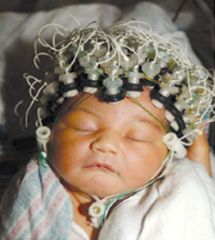
(temporal) $
|
|
|
NIRS (Near InfraRed Spectroscopy)
|
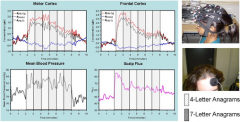
(spatial-blood) $
|
|
|
MEG (Magnetoencephalogrophy)
|

(temporal & spatial) $$$$
|
|
|
fMRI
|

(spatial-blood) more for adults than infants $$$$
|
|
|
Phonetic Learning (2 Phases)
|
• Phase 1 (6-8 wks) infant primed to learn all phonemes
• Phase 2 (>8 wks) phonemes of non-native language drop off |
|
|
NLNC Hypothesis
|
Native Language Neural Commitment
the faster infants committed to native language, faster language acquisition |
|
|
Motherese
|
super annunciation, stretching acoustic cues (autism does not prefer)
|
|
|
Word learning of infants at 4 months
|
recognition of own name
|
|
|
Word learning of infants at 7 months
|
listen longer to passages containing familiar words than unfamiliar (L temporal & parietal)
|
|
|
Broca’s area
|
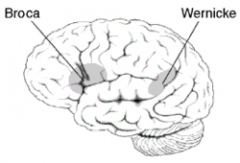
speech production, MOTOR.
• LIFG. |
|
|
Wernicke’s area
|
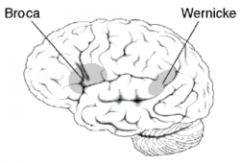
speech perception & comprehension.
• LSFG. Auditory/speech areas of parietal & temporal |
|
|
Arcuate fasciculus
|
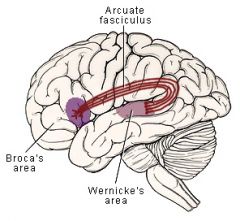
(white matter axons): connects receptive areas + motor
• Looping between sensory & motor • “Unification area”: memory links with temporal/cognition from prefrontal cortex |
|
|
Link Between Speech Perception & Production
|

• Systems tightly coupled w/complex interactions
• Auditory cortex activated during both perception & production |
|
|
Aphasia
|
brain damage/stroke to specific brain area leading to language disorder
|
|
|
Broca’s aphasia
|
(expressive) Fred Fried
o Difficult to initiate speech, non-fluent, labored, halting Agrammatism (telegraphic speech) o Aware of deficits, but just cannot get words out |
|
|
Wernicke’s aphasia
|
(receptive)
o Normal grammar, tone, etc BUT content incorrect & unable to understand language (both written & spoken) o Paraphasia (errors in words, treen = train) o Unaware of deficits due to lack of comprehension |
|
|
Conduction aphasia
|
(associative)
o Arcuate fasciculus, or integration areas damaged o Unable to repeat words o Capable of conversation & fluent, but paraphrasic (prone to errors); can understand and self-correct |
|
|
Global aphasia
|
o Symptoms of both receptive and expressive aphasias; cognition intact
o L side brain affected |
|
|
Anomic aphasia
|
o Unable to recall words/names
o L parietal/temporal |
|
|
Progressive aphasia
|
o Due to brain degeneration/Alzheimer’s
|
|
|
Auditory Processing Disorder
|
• Sensory processing deficit; difficulties in recognizing and interpreting language; can be developmental or acquired (unknown causes, maybe damage to hearing during development)
• Comorbid w/learning d/o |
|
|
Dyslexia
|
learning disability, impairments in fluency, comprehension, reading
Other disorders w/language impairment: • ADHD, Down syndrome, Autism (Joint attention, echolalia, delayed development) |
|
|
Dyslexia - neurobiology
|
• Inferior frontal gyrus, inferior parietal lobe, middle temporal
|
|
|
Prosody
|
placing appropriate stress, timing, intonation on words in sentences. Defecits = lack of context comprehension/emotional tone, jokes emotions, social gatherings
|
|
|
Prosody - neurobiology
|
• Controlled by R hem (similar to arrangement of Brocas & Wernicke’s).
o Right inferior frontal gyrus (production); o Right temporoparietal region (comprehension) |

